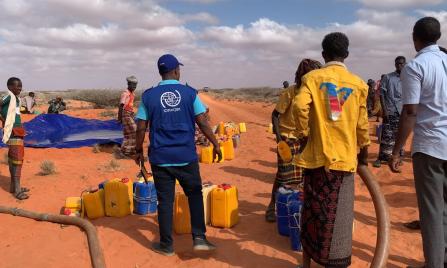-
Who we are
WHO WE AREThe International Organization for Migration (IOM) is part of the United Nations System as the leading inter-governmental organization promoting since 1951 humane and orderly migration for the benefit of all, with 175 member states and a presence in 171 countries.
-
Our Work
Our WorkAs the leading inter-governmental organization promoting since 1951 humane and orderly migration, IOM plays a key role to support the achievement of the 2030 Agenda through different areas of intervention that connect both humanitarian assistance and sustainable development.
What We Do
What We Do
Partnerships
Partnerships
Highlights
Highlights
- Where we work
-
Take Action
Take Action
Work with us
Work with us
Get involved
Get involved
- Data and Research
- 2030 Agenda
Humanitarian crises are growing in scale, complexity, and severity. Displacement is at unprecedented levels. Across the world, millions have lost their homes, livelihoods, and their lives.
When crises occur or disaster strikes, be it in Afghanistan, Venezuela, Yemen, Ukraine, across the East and Horn of Africa, or in the Sahel Region and many other parts of the world, local communities are always the first to respond. This has pushed IOM to expand ways to empower and engage local communities.
This World Humanitarian Day, the International Organization for Migration (IOM) joins the United Nations System in recognizing the role local communities, authorities and organizations play in the response to humanitarian crises around the world. Often local humanitarians face the brunt of violence targeting aid workers. Their safety must be ensured.
The sheer scale of today’s humanitarian crises is one that surpasses the capacity of any single individual, government, or organization. They can only be addressed through combined efforts.
It takes a village to support people in crisis.
On this occasion, we are shedding light on some key facts and stories of humanitarians - local volunteers, civil society, and international organizations - working together to ease suffering and bring hope.
Global Key Facts1
The devastating combination of conflicts, the climate emergency, geopolitics, the COVID-19 pandemic, and poverty has caused the number of people who need humanitarian assistance to reach a record 303 million.
IOM is one of the largest agencies responding to crisis situations worldwide. In 2021, IOM reached 31.7 million people, including internally displaced persons, refugees, and migrants.
Humanitarian action takes place in dangerous and unstable contexts, with national aid workers disproportionately at risk. Some 98 per cent of the aid workers who died were national staff and 2 per cent were international staff.
So far this year, 146 aid workers have been attacked, leading to 42 fatalities, 40 of them national aid workers, according to Humanitarian Outcomes.
-----------
1Source: UN OCHA, 2022





